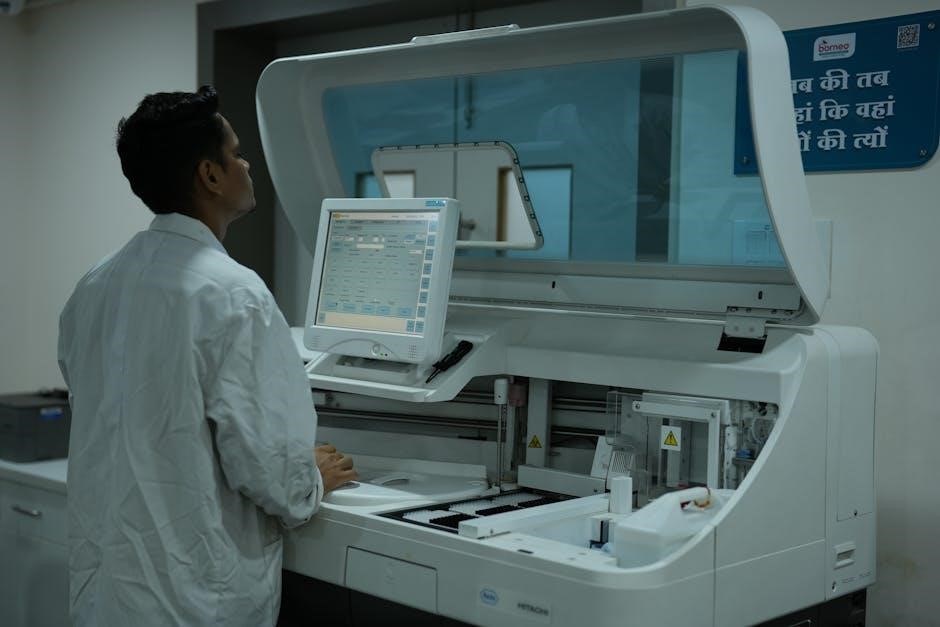Open access revolutionizes scientific research by enabling unrestricted sharing of findings, fostering collaboration, and accelerating discovery. It bridges gaps between scientists, academicians, and the public, promoting transparency and innovation globally.
1.1 The Importance of Open Access for Scientists and Academics
Open access is pivotal for scientists and academics as it enables the free sharing of research findings, fostering collaboration and accelerating scientific discovery. By removing subscription barriers, it ensures that knowledge is accessible to all, promoting transparency and innovation. This unrestricted access allows researchers to build on existing studies, leading to breakthroughs that might otherwise be delayed. For academics, open access increases the visibility and impact of their work, enhancing their professional reputation. It also bridges gaps between institutions, enabling researchers in resource-limited settings to contribute and benefit equally. Ultimately, open access empowers the global scientific community, driving progress and ensuring that knowledge serves humanity without restrictions.
1.2 Breaking Down Subscription Barriers for Scientific Knowledge
Subscription barriers have long hindered access to scientific knowledge, limiting researchers and the public to costly journals. Open access initiatives dismantle these barriers, providing free and unrestricted access to research papers. By eliminating paywalls, scientists can access critical information without financial constraints, fostering a more inclusive and collaborative research environment. This shift not only benefits individual researchers but also institutions in developing regions, enabling them to participate fully in global scientific advancements. Open access platforms and repositories, such as DOAJ and CORE, play a crucial role in making high-quality research freely available. As a result, scientific knowledge is democratized, accelerating innovation and ensuring that progress is not confined by economic limitations.

The Role of AI in Scientific Research
AI transforms scientific research by automating processes, enhancing literature reviews, and advancing data analysis, thereby accelerating discoveries and shaping the future of science and innovation.
2.1 AI Scientist: A Tool for Automating Scientific Processes
AI Scientist, developed by Sakana AI, is a groundbreaking tool designed to automate scientific processes, enabling researchers to focus on complex problem-solving. By leveraging machine learning, it streamlines tasks such as data analysis, literature reviews, and experiment design, significantly reducing manual effort. This innovative platform enhances research efficiency, accelerates discovery, and minimizes human error. AI Scientist is particularly valuable in fields like materials science and medical research, where vast datasets and intricate patterns require precise analysis. Its ability to identify trends and predict outcomes empowers scientists to explore new frontiers, making it an indispensable asset in modern research environments. This tool exemplifies how AI is transforming the scientific landscape, fostering innovation and collaboration across disciplines.
2.2 AI’s Impact on Literature Review and Data Analysis
AI significantly enhances literature review and data analysis by automating tasks, improving accuracy, and accelerating workflows. AI tools can swiftly analyze vast volumes of scientific papers, identifying relevant studies and extracting key insights. This capability is particularly valuable for researchers overwhelmed by the exponential growth of scientific publications. In data analysis, AI algorithms can detect complex patterns, process large datasets, and perform statistical computations with precision. These advancements not only save time but also reduce human error, enabling scientists to focus on interpreting results and formulating hypotheses. AI-driven tools, such as those mentioned in scientific reports, are reshaping how researchers approach literature reviews and data analysis, fostering more efficient and innovative scientific inquiry.
Accessing Free Research Papers
Accessing free research papers is essential for advancing scientific knowledge. Websites like DOAJ, CORE, and PubMed, along with tools like Unpaywall and ResearchGate, provide free access to scholarly articles, enabling researchers to explore and utilize scientific findings without financial barriers, thereby fostering innovation and collaboration globally.
3.1 Best Websites for Downloading Research Papers
Several websites provide free access to research papers, enabling scientists and scholars to download high-quality scientific literature. arXiv.org is a leading platform for preprints in fields like physics, mathematics, and computer science. ResearchGate and Academia.edu allow researchers to share and download papers directly. Google Scholar (scholar.google.com) offers a vast repository of scholarly articles across disciplines. ScienceOpen and The Lens also provide extensive collections of open-access research papers. These platforms ensure that scientific knowledge is accessible to everyone, fostering collaboration and innovation. By utilizing these resources, researchers can stay updated with the latest advancements without financial barriers, promoting a more inclusive and progressive scientific community.
3.2 Utilizing Databases Like DOAJ, CORE, and PubMed
Databases like DOAJ, CORE, and PubMed are invaluable resources for accessing free research papers. The Directory of Open Access Journals (DOAJ) curates high-quality, peer-reviewed journals across various disciplines. CORE, the world’s largest aggregator of open-access research, provides access to millions of articles from repositories and journals. PubMed, a database of biomedical literature, offers free access to millions of citations and abstracts, many linked to full-text articles. These platforms ensure that scientists and researchers can access credible and comprehensive scientific information without subscription barriers. By leveraging these databases, researchers can efficiently locate and download research papers, fostering knowledge sharing and advancing scientific progress globally.
3.3 Tools Like Unpaywall and ResearchGate for Free Access
Tools like Unpaywall and ResearchGate are essential for accessing free research papers. Unpaywall, a browser extension, identifies legal, open-access versions of paywalled articles, often linking to free PDFs. It color-codes search results, indicating availability of free versions. ResearchGate, a social networking platform for scientists, allows users to share and download research papers directly. Many researchers upload their work to the platform, making it accessible to the public. These tools bridge the gap between subscription-based content and open-access knowledge, enabling scientists to access critical research without financial barriers. By leveraging these platforms, researchers can efficiently locate and download scientific papers, promoting collaboration and advancing scientific discovery globally.

The Daily Life of a Post-Doctoral Research Scientist
A post-doctoral research scientist’s day involves conducting experiments, analyzing data, collaborating with teams, and overcoming challenges, as seen in a Janet Thornton Fellow’s typical day at the Wellcome Trust Sanger Institute.

4.1 A Typical Day in the Life of a Research Scientist
A research scientist’s day is dynamic, balancing experiments, data analysis, and collaboration. They design studies, test hypotheses, and troubleshoot experiments, often working in labs or offices. Time management is crucial, as they juggle multiple projects, meetings, and deadlines. Scientists also engage in literature reviews, staying updated on the latest discoveries. Collaboration with colleagues, both locally and internationally, is common, fostering innovation. Challenges include managing resources and interpreting complex data, but the reward lies in contributing to scientific knowledge. A Janet Thornton Fellow at the Wellcome Trust Sanger Institute exemplifies this, showcasing dedication and expertise in their daily pursuits, highlighting the blend of independence and teamwork in scientific endeavors.
4.2 Challenges and Rewards in Scientific Research
Scientific research presents unique challenges, including managing limited resources, interpreting complex data, and navigating competitive funding landscapes. Researchers often face setbacks, such as failed experiments or lengthy publication processes. Despite these hurdles, the rewards are profound. Discoveries that advance knowledge or improve lives bring immense fulfillment. Collaboration with global experts fosters innovation and shared progress. The dedication required to pursue scientific inquiry demands resilience and passion. For many, the opportunity to contribute to humanity’s understanding of the world is deeply rewarding. Balancing challenges and rewards, scientists thrive in an environment where curiosity drives continuous exploration and problem-solving, shaping the future of various fields and inspiring future generations to pursue scientific careers.
The Evolution of Scientific Publishing
The evolution of scientific publishing has transformed from print to digital, enhancing accessibility and global sharing of research through open access and advanced technological platforms, accelerating knowledge dissemination.
5.1 Historical Development of Scientific Papers
The historical development of scientific papers reflects the progression of human knowledge and communication. Early papers were often rudimentary, lacking the structure and rigor of modern research. Before 1940, many papers seemed primitive, as fundamental concepts like DNA’s role in genetic inheritance were unknown. The discovery of DNA’s structure marked a pivotal moment, transforming scientific inquiry. Over time, papers evolved to include detailed methodologies, data analysis, and peer-reviewed validation. This shift ensured transparency and credibility, laying the foundation for contemporary research practices. The transition from print to digital publishing further revolutionized access, enabling global dissemination of scientific findings. Historical papers remain invaluable, offering insights into the journey of scientific discovery and the methodologies that shaped modern science.
5.2 The Shift from Print to Digital Publishing
The transition from print to digital publishing has transformed how scientific papers are accessed and shared. Digital platforms now dominate, offering unprecedented accessibility and convenience. Tools like Unpaywall and ResearchGate enable free access to research, breaking down subscription barriers. Databases such as PubMed and Google Scholar provide vast repositories of scientific literature, making it easier for researchers to find and download papers. This shift has also enhanced collaboration, with features like sharing and citation tracking. However, it raises challenges, such as ensuring the quality and integrity of openly available content. Despite these issues, digital publishing has revolutionized science, fostering a more connected and efficient research community. The ability to access scientist pdf files instantly has become a cornerstone of modern academic work, driving innovation and knowledge sharing globally.

The Future of Science and Technology
The future of science and technology is driven by emerging trends like AI, quantum computing, and biotechnology, reshaping industries and fostering innovation. Open access and global collaboration accelerate progress, ensuring scientific breakthroughs benefit humanity.
6.1 Emerging Trends in Scientific Research

Emerging trends in scientific research emphasize the integration of AI, quantum computing, and biotechnology to tackle complex challenges. AI tools like AI Scientist automate processes, enhancing efficiency and accuracy. Interdisciplinary approaches are fostering innovation, blending fields like materials science and life science. Open access platforms and digital tools, such as Unpaywall, facilitate knowledge sharing, accelerating discovery. These advancements are reshaping how researchers collaborate and publish, ensuring science remains dynamic and inclusive. The future promises groundbreaking developments, driven by technology and global collaboration, ultimately benefiting humanity.
6.2 The Role of AI in Shaping Future Scientific Discoveries
AI is revolutionizing scientific research by automating processes, enhancing data analysis, and accelerating discovery. Tools like AI Scientist streamline literature reviews and experiments, enabling researchers to focus on innovation. AI’s ability to process vast datasets unlocks new insights in fields like drug discovery and climate modeling. It fosters collaboration by providing platforms for sharing findings, promoting global scientific advancement. As AI evolves, it promises to tackle complex challenges, driving transformative breakthroughs. Ethical considerations remain crucial to ensure responsible use. Ultimately, AI empowers scientists to explore uncharted territories, shaping a future where technology and human ingenuity converge to solve humanity’s most pressing problems.

Career Opportunities for Scientists
Scientists can explore diverse roles in academia, industry, and research institutions. ISRO offers Scientist/Engineer vacancies with selection processes including written tests and interviews, providing opportunities across various scientific disciplines.
7.1 Job Roles and Specializations in Science
Scientists can pursue diverse roles such as research scientists, data scientists, biomedical engineers, and environmental scientists. Specializations include fields like astrophysics, biotechnology, and materials science. ISRO offers Scientist/Engineer positions across disciplines like Electronics, Mechanical, and Computer Science, requiring expertise in cutting-edge technologies. Professionals may also work in interdisciplinary fields, combining biology with engineering or chemistry with informatics. Roles often involve conducting experiments, analyzing data, and developing innovative solutions. Opportunities exist in academia, government labs, and private industries, with varying requirements for advanced degrees and certifications. The selection process for roles like ISRO Scientist/Engineer includes written tests and interviews, ensuring candidates meet high standards. These roles drive scientific advancements and address global challenges, making them both rewarding and impactful.
7.2 ISRO Scientist/Engineer Vacancies and Selection Process
ISRO regularly announces vacancies for Scientist/Engineer positions, attracting candidates across disciplines like Electronics, Mechanical, and Computer Science. The selection process typically includes a written test followed by an interview, ensuring only the most qualified candidates are chosen. Previous years’ question papers are available for Electronics, Mechanical, and Computer Science, aiding preparation. These roles require a deep understanding of advanced technologies and innovative problem-solving skills. The recruitment drive aims to fill 302 vacancies, with candidates selected based on merit and expertise. ISRO’s rigorous selection process ensures high standards, making these positions highly competitive and prestigious. Candidates must demonstrate technical proficiency and adaptability to contribute to ISRO’s cutting-edge projects and advancements in space exploration and technology.
The Importance of Interdisciplinary Science
Interdisciplinary science merges diverse fields, fostering innovative breakthroughs and solving complex problems. It integrates knowledge from multiple disciplines, driving advancements and addressing global challenges effectively and creatively.
8.1 Combining Diverse Fields for Innovative Research
Interdisciplinary research bridges gaps between seemingly unrelated fields, fostering groundbreaking discoveries. By integrating concepts from AI, biology, and materials science, scientists unlock novel solutions to complex challenges. For instance, AI algorithms applied to medical imaging have revolutionized diagnostics, while interdisciplinary approaches in geoscience and environmental studies address climate change more effectively. This fusion of expertise accelerates innovation, enabling researchers to tackle multifaceted problems from unique angles. Tools like ResearchGate and Google Scholar facilitate collaboration, making it easier for scientists to share insights across disciplines. Such integration not only enhances the quality of research but also drives societal progress, proving that the sum of diverse fields often exceeds their individual contributions.
8.2 Case Studies of Interdisciplinary Scientific Breakthroughs
Interdisciplinary research has led to remarkable breakthroughs, as seen in the development of CRISPR technology, combining biology and computer science. Similarly, AI-driven medical imaging has transformed diagnostics by merging AI algorithms with radiology. These cases highlight how integrating diverse fields accelerates innovation. For instance, the fusion of geoscience and environmental studies has advanced climate modeling, while interdisciplinary approaches in materials science and physics have led to breakthroughs in energy storage. Such collaborations demonstrate the power of combining expertise, fostering solutions that might not emerge within a single discipline. Platforms like ResearchGate and Google Scholar facilitate these interactions, enabling scientists to share insights and drive transformative advancements across fields.

Ethical Considerations in Scientific Research
Ethical research ensures integrity, transparency, and accountability, safeguarding against misconduct and bias. It promotes trust in scientific findings, fostering responsible innovation and public confidence in advancements.
9.1 Ensuring Integrity and Transparency in Research
Ensuring integrity and transparency in research is crucial for maintaining trust and credibility. This involves adhering to ethical guidelines, accurately reporting data, and disclosing potential conflicts of interest. Researchers must avoid falsification, fabrication, or plagiarism, which can undermine the validity of scientific findings. Transparency includes making research methods and data openly accessible, allowing for replication and verification by others. Institutions and journals play a key role by implementing strict ethical standards and promoting open communication. By upholding these principles, scientists contribute to a culture of honesty and accountability, which is essential for advancing knowledge and addressing global challenges effectively.
9.2 Addressing Ethical Dilemmas in Scientific Publishing
Ethical dilemmas in scientific publishing often arise from conflicts of interest, data manipulation, or authorship disputes. Addressing these issues requires robust editorial policies and transparent review processes. Journals must enforce strict guidelines to prevent plagiarism and ensure accurate reporting of research findings. Authors should disclose any potential conflicts of interest to maintain credibility. Additionally, ethical oversight bodies and institutional review boards play a crucial role in monitoring compliance with ethical standards. Open communication and accountability are essential to resolve disputes and uphold the integrity of published work. By fostering a culture of ethical responsibility, the scientific community can mitigate these challenges and maintain public trust in research outcomes.

Conclusion
Open access and AI are transforming science, accelerating discovery and fostering global collaboration. Ethical integrity ensures research remains trustworthy, driving future progress and innovation for humanity’s benefit.
10.1 The Transformative Power of Open Access and AI in Science
Open access and AI are revolutionizing science by democratizing knowledge and enhancing research efficiency. Open access eliminates subscription barriers, enabling global collaboration and accelerating discovery. AI tools, like AI Scientist, automate complex processes, analyze vast datasets, and assist in literature reviews, saving time and improving accuracy. Together, they foster innovation, transparency, and inclusivity, breaking down traditional silos. This synergy empowers researchers to address global challenges more effectively, ensuring scientific progress benefits humanity as a whole. The integration of open access and AI creates a future where knowledge is freely accessible and research is more efficient, paving the way for groundbreaking discoveries.

10.2 The Future of Scientific Collaboration and Knowledge Sharing
The future of scientific collaboration and knowledge sharing lies in digital platforms and open access initiatives. Tools like ResearchGate and Unpaywall are bridging gaps, enabling researchers to share findings freely. AI-driven platforms enhance collaboration by automating literature reviews and data analysis, fostering innovation. Interdisciplinary research is thriving as scientists from diverse fields connect, driven by shared goals. Open access ensures that knowledge reaches global audiences, accelerating breakthroughs. The integration of AI and open access creates a collaborative ecosystem, breaking down traditional barriers. This shift promises a future where science is more inclusive, transparent, and impactful, ensuring that discoveries benefit humanity as a whole.
